2022's relative drought leads to an absolutely packed year of major epics.
It’s been a real period of feast or famine in the video game industry of late. Last year
in this space, we lamented how COVID-related development delays meant a dearth of big-budget blockbusters that would usually fill a year-end list. In 2023, many of those delays finally expired, leading to a flood of long-anticipated titles over just a few months.
But the year in games didn’t stop there. Beyond the usual big-budget suspects, there were countless delightful surprises from smaller indie studios, many of which came out of nowhere to provide some of the most memorable interactive experiences of the year.
These two trends make it difficult to narrow this year’s best games down to just 20 titles. The “shortlist” we assembled during the winnowing process easily approached 50 titles, most of which could have easily made the list in a less packed year—or been swapped with a game that did make this year’s list.
Looking back years from now, 2023 may be mentioned in the same breath as 1998 and 2007 as years that were packed to the gills with classics. Here are 20 titles released this year that we think will stand the test of time, sorted in alphabetical order, with a single "Game of the Year" pick at the end.
Against the Storm
Eremite games; Windows
With most games I played and wrote about this year, even the titles I really liked, I would tell myself, “I could see playing this more.” With Against the Storm, I’m not just imagining it, I’m actively plotting ways to make it happen.
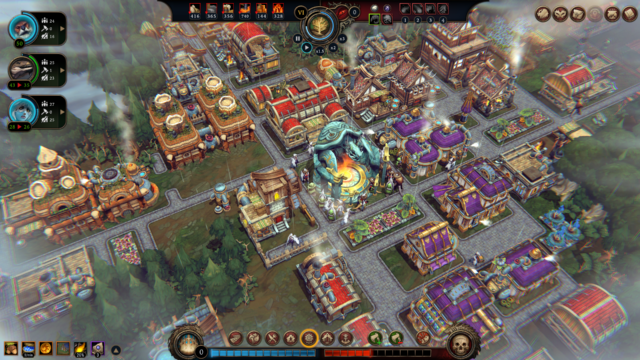
A (rather well-organized) village in Against the Storm, with the Hearth at center, constantly burning the resources you acquire.
This game is stuck in my mental queue because of how surprisingly well the core gameplay loop works. You create the kinds of little villages you’d make in a typical real-time strategy game, except there’s no real-time battle, just a gradual push against time to gather enough resources, deliver the right goods, and keep everyone moderately happy. You can save any time, but each session can also be played in about an hour. It’s deep, but it’s also calm. Even the “roguelite” map-wiping aspect of the game isn’t a punishment but, rather, a reminder not to worry too much about any one level.
Against the Storm is also now Steam Deck Verified, having made lots of changes to how controllers, gamepads, and on-screen text are displayed for that tinier screen. It's a smart move to make this session-friendly game more couch-capable.
You can pick out a few distinct genre influences in Against the Storm, a handful of specific art homages, and probably quite a few mechanics plucked from other games. But it is very much its own game, one that has been tuned well over its early access period. I keep finding myself hoping for little stretches of time where I can break away from daily life so I can have a bunch of villagers, a queen, and unknowable forest spirits demand more and more of me. It’s quite weird, but it works.
-Kevin Purdy
Alan Wake 2
Remedy Entertainment; Windows, PS5, Xbox Series X|S
I am not really in the target audience for
Alan Wake 2. I only played a few brief moments of
its predecessor, and I’ve never really gone deep on survival horror shooters, having bounced off the
Resident Evil titles in my youth. And while I was initially thrilled with developer Remedy’s last title,
Control, the combat felt too repetitive and grinding for me to keep pushing through it for one more head-melting story reveal or another cleverly worded office memo.

Welcome to Cauldron Lake.
Remedy
And yet I think Alan Wake 2 is an inspired, fascinating, entertaining game, one that I’d recommend to nearly anybody. Anybody, in particular, who digs The X-Files, Twin Peaks, Stephen King, Resident Evil, meta-fiction, Control, True Detective, or pondering dark myths amid the beauty of the Pacific Northwest’s majestic, damp forests or a lucid-dream version of New York City.
AW2 gives Remedy the breadth and budget to tell the kinds of stories it's best at telling. Even if I found the gun-focused but bullet-constrained combat a bit of a slog at times, I wanted to push through. I wanted to watch Saga Anderson discover and react to the reality-altering mystery she was investigating. I wanted to have more moments like when Wake was thrust onto a talk show couch, unaware of the book he was there to promote.
There’s also a musical number. This isn’t a game where you can see the beats coming.
Like 2022’s game of the year, Elden Ring, AW2 feels like a distillation but also an expansion of all the games that came before it. It’s not going to be for everyone, but it provides a wonderful service for those who commit to sitting down with it.
-Kevin Purdy
Brotato
Thomas Gevraud; Windows, Switch, iOS, Android
Last year, the cheap, pixel-graphics indie roguelite
Vampire Survivors was my personal game of the year. I wasn’t alone in my obsession. Although it wasn’t technically the first of its kind,
Vampire Survivors kick-started a new genre in which an auto-attacking hero faces down ever-increasing hordes of enemies. I’ve played a ton of these “Survivor-likes” over the past year, and many of them are quite good. My favorite by far, though, is
Brotato, which saw its 1.0 release this year.
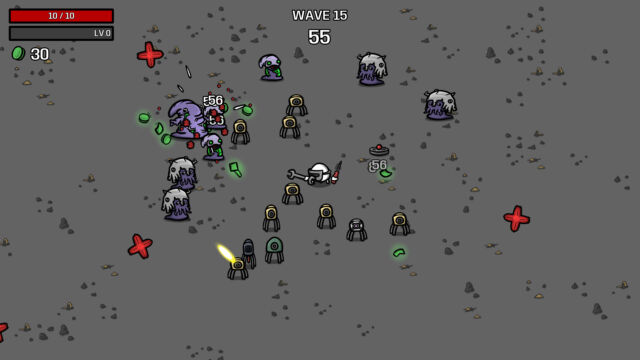
Look out, little potato.
Blobfish
In Brotato, you maneuver the titular potato-bodied hero around a small arena. Enemies rush toward your position, and when they’re in range, your character attacks them automatically. But instead of the 20- to 30-minute rounds common in the genre, a Brotato run is split into 20 bite-sized fights that last anywhere from 20 to 90 seconds.
Defeated enemies drop “materials,” which double as experience points and money. You visit a shop between rounds and can spend as much money as you want to buy items and weapons to buff up your character. This is where the game gets its addictive pull. There are 16 main stats, and the key to success is leaning into the ones that help your character the most. Items often have a positive and a negative, so balancing is key.
In short, the game is a min-maxer’s dream.
Forty-four unique characters, six difficulty levels, dozens of weapons, and hundreds of items—unlocked as you play the game—ensure you have a ton of content to chew through. The best thing about the game is coming up with wacky build ideas and seeing if you can make them happen. Adjusting your stats from round to round makes a huge difference, and choosing the right items becomes surprisingly intuitive.
The game is a scandalously cheap $5 (or free to try on mobile). If you are at all interested in stat-building in games, you need to try this.
-Aaron Zimmerman
Chants of Sennaar
Rundisc; Windows, PS4, Xbox One, Switch
Last year, Tunic spiced up the action-adventure genre simply by hiding many of its gameplay systems behind an inscrutable, hard-to-translate instruction booklet that players found only as they played. Chants of Sennaar leans hard into a similar concept, making the inability to communicate in an unknown language the key gameplay mechanic.
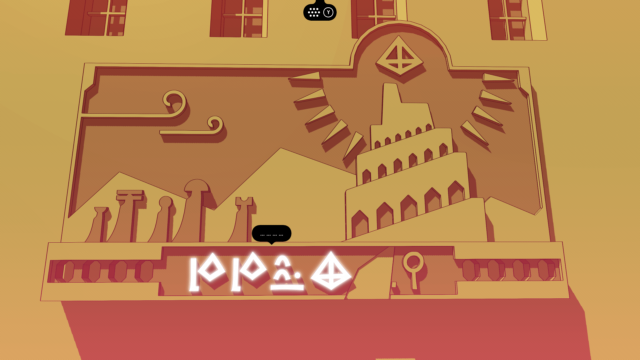
Deciphering symbols is at least half the fun...
The game doesn’t give you any real guidance on how to translate the multiple symbolic languages needed to navigate and make sense of its archaic desert civilization. Instead, it rewards you for paying close attention to context. That can mean something as simple as noticing that a symbol next to a knight on a poster probably means “knight” or as complicated as recognizing that another symbol appearing next to two tall things suggests an adjective meaning “tall.”
Before long, you’re eavesdropping on the game’s cult-like assortment of rogue figures, trying to make sense of the commands they issue through symbolic word bubbles, then using those words to guide yourself around a map full of loops, corridors, and stairways. The game also uses an excellent interface for this whole process, letting you record guesses for words you’re not sure of in an in-game notebook, then rewarding you with instant in-game translations once you’ve filled out an entire page of concepts in its pictorial glossary.
The observe-and-identify process creates a satisfying kind of logic puzzle that will tickle anyone who liked Curse of the Obra Dinn or The Case of the Golden Idol. But the game will also give you a new perspective on the process of language acquisition and everyday communication that you might otherwise take for granted.
-Kyle Orland
Cocoon
Geometric Interactive; Windows, PS4/5, Xbox One/Series X|S, Switch
Dude, did you ever think that, like, our whole universe might just be inside, like, this little ball that’s part of a
bigger universe? What if you could, like, jump out of that ball into the bigger universe and carry our whole universe around like a glowing ball? And then you could find, like, other balls with other universes that are completely different to explore? Wouldn’t that be cool?
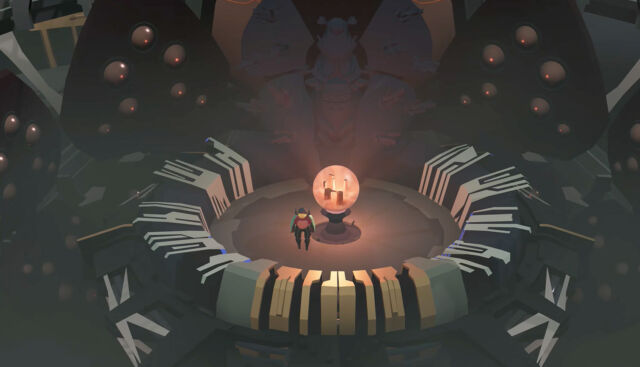
Careful with that universe...
OK, it’s hard to describe the concept of Cocoon without sounding like a baked college student in the middle of a 3 am BS session in the dorms. But that trippy-sounding concept forms the basis for a truly memorable exploration-based puzzle game, where shuffling between portable universes is a matter of course. Figuring out how to juggle those universes and use them to activate some intricate machinery quickly becomes confusing in the most satisfyingly mind-bending way, requiring some truly non-intuitive world-spanning solutions.
While the universe-hopping gameplay is suitably brain-tickling, Cocoon distinguishes itself through stellar art and sound design. Without a single word of dialogue, the game effectively establishes an arcane world of complex machinery, archaic architecture, and barely comprehensible malevolent forces that are pulling the strings behind the scenes. This shines through especially well in the boss battles, where fantastical, vaguely robotic beasts try to throw you off using massive, firmament-shaking attacks.
Cocoon may be a tough game to put into words, but that doesn’t mean its mind-bending concept won’t stick with you.
-Kyle Orland
Darkest Dungeon 2
Red Hook Studios; Windows
Darkest Dungeon 2 isn’t for everyone. In particular, many super-fans of the original game might be unhappy with the shift from a 2D X-COM-like experience to a run-based roguelite. I’ll admit that the changes threw me at first, too, and the game is certainly not perfect. Still, I love it.
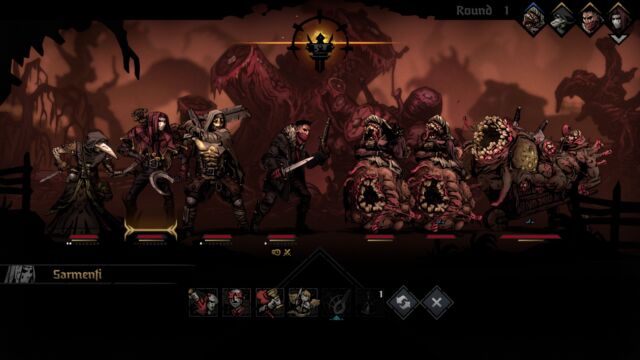
Well, this is grotesque.
The grim, gothic fantasy aesthetic makes a welcome return from the first game, as does excellent narration from voice actor Wayne June. Darkest Dungeon had style, and the sequel’s 3D models only make it better.
This time, instead of crawling through dungeons, you rumble down a dark road in a stagecoach, choosing your path on a Slay the Spire-style map filled with harrowing encounters. You no longer shepherd a huge roster of characters through a long campaign; instead, you go on self-contained roguelite “runs” and upgrade those characters between excursions.
The turn-based positional combat was always the star of the show in the first game, and it has been tuned to perfection in the sequel. It’s simultaneously streamlined and more complex, with a fun “token” system that shows you the board state at a glance. Randomness is also more manageable this time around, fixing one of my major gripes with the combat in the original.
Runs are long enough that the game can feel a little awkward, but again, that combat is good enough that I’m more than happy to settle in for a couple of hours. Developer Red Hook Studios took a chance with its sequel, and I, for one, was here for it.
-Aaron Zimmerman
Dave the Diver
Mintrocket; Windows, MacOS, Switch
The first time I tried Dave the Diver, I bounced off it almost immediately. The fish-harpooning sections felt too slow and boring, while the sushi restaurant serving sections felt like an oversimplified version of Diner Dash. I couldn’t see what had everyone so excited about this game.
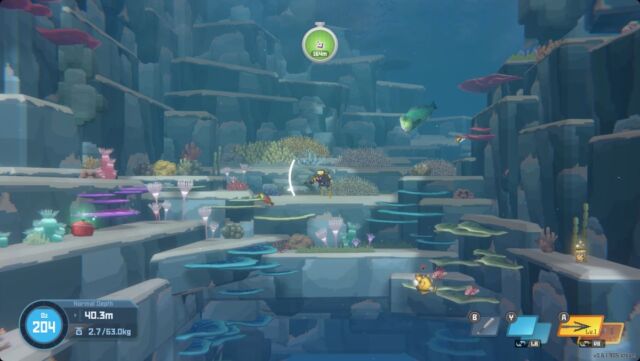
Dive right in.
The second time I dove in, though, I was quickly hooked into the game’s grabby, insidious loop of rewards and new gameplay systems. Before long, I was fighting giant sharks, searching for rare condiments to enhance recipes, hiring staff for a bustling restaurant, and saving up for enhancements to find interesting new sea areas. All the while, I was unlocking the mysteries of a wacky story involving a lost civilization of merpeople and loving every minute of it.
The disparate gameplay systems might sound overwhelming, but they’re introduced slowly enough to create an addictive loop that’s more than the sum of its parts, all aided by excellent detailed pixel art and sound design. Once I got over the hump, I had hours' worth of “just one more dive” sessions to get that next enhancement or find that next key item.
It might not be the year’s deepest gameplay, but it is definitely the year’s deepest setting.
-Kyle Orland
Diablo IV
Blizzard; Windows, PS4/5, Xbox One/Series X|S
Diablo IV arrived after an infamously long and troubled development. After
Diablo II became one of the most beloved titles in PC gaming history,
Diablo III faced some unpopular design choices and technical problems. But after a new director took on the project, a new, improved expanded version of
Diablo III became widely beloved by many for years.
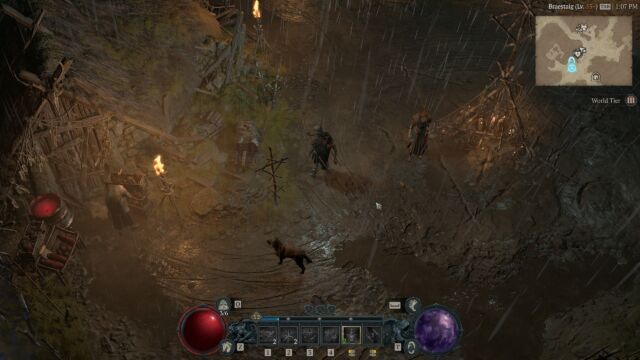
Come for the fun, stay because you got stuck in the mud.
That saga left Diablo IV facing a complicated web of player expectations. The director who successfully overhauled Diablo III was tasked with leading Diablo IV, but he left the project when Blizzard's leadership didn't like his ideas for an ambitious overhaul of the franchise. The game we got from new leadership ended up being a greatest hits of ideas from Diablo II and the updated Diablo III, packaged in the safest design philosophy possible—the opposite of the original vision.
But “safe” isn't necessarily a bad thing. Diablo IV's gameplay loops are engaging and tight, its narrative presentation is on a whole new level, and its online components formalize the multiplayer aspects of Diablo II and Diablo III that sometimes felt more accidental than intentional. Diablo IV has the two things developer Blizzard is arguably best known for—mass appeal and polish—in spades.
Diablo IV won’t have the cultural impact that Diablo II did, but it landed in a very different time, when competitors inspired by Diablo's halcyon era are giving it a run for its money. Sure, that means it's just another action RPG amid various competitors now, but that Blizzard polish means it's undoubtedly the most accessible option—and one of the most entertaining, too.
-Samuel Axon
Humanity
Ttha Ltd.; Windows, PS4/5
Anyone who remembers
Lemmings knows the joy of guiding a huge group of mindless, marching drones using various indirect commands.
Humanity extends that same satisfying concept into 3D, crafting a variety of clever puzzles based around the object of keeping literally thousands of tiny people from marching to their doom.
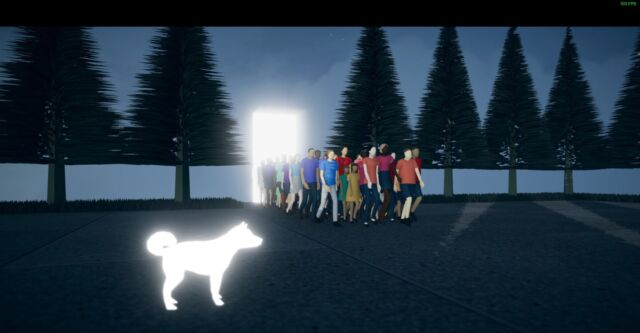
Here they come, the humans who have no idea what they're doing, but they're doing it together. In the game, I'm saying.
Things start simply enough, with your adorable dog avatar pointing the marching line of humanity in one direction or another to avoid simple static obstacles. Before long, though, you’re directing the amassed hordes to push barriers that become bridges, jump across various gaps, swim through mid-air pools, and split into subgroups to complete multiple goals at once.
Humanity does a good job of letting players select their own difficulty as they play. Simply getting your line of humans to the goal is often pretty straightforward, but doing so while also collecting any number of giant golden statues dotting each course can require some real mind-stretching. This is a game that rewards out-of-the-box thinking and requires some novel experimentation with limited resources to get through at points.
Beyond the puzzles, though, the game's haunting presentation makes Humanity stick with you. There’s something almost poetic about the seemingly endless marching lines of thousands of tiny people, each struggling individually through the crowd while forming a teeming mass through their conformity. Humanity’s art design reaches a level of visual poetry that few other titles can match, and that’s a big part of what helps it stand out from its peers this year.
-Kyle Orland
The Legend of Zelda: Tears of the Kingdom
Nintendo; Switch
It would have been really easy for Nintendo to simply rest on its laurels for the sequel to 2017’s smash hit
The Legend of Zelda: Breath of the Wild. A slight remix that offered the same basic mix of open-world exploration and physics-based puzzle solving would have more than satisfied an audience hungry for more (see this year’s
Spider-Man 2 for an example of a game that largely went down this route).
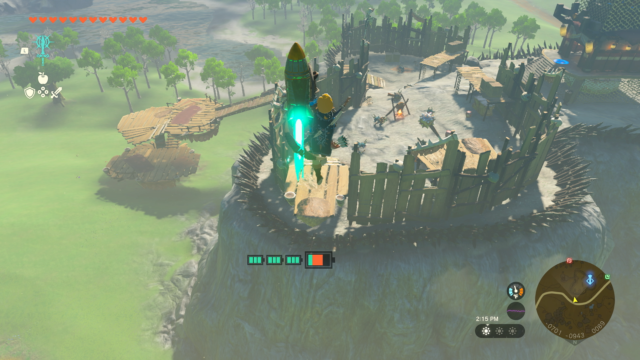
Model rocketry, Zelda-style.
Nintendo
Instead, Nintendo layered Tears of the Kingdom with an entirely new building and crafting system that greatly expands the interactive possibility space. By allowing players to join random items and detritus into vehicles, shelters, new weapons, and more, the game opens up countless new options for puzzle-solving and joyful creativity. The sheer number of possibilities is staggering, as should be apparent to anyone who has seen some of the more ridiculous creations littering social media and video sites.
But Nintendo didn’t just stop there. The ability to climb through ceilings and reverse time feel like the kind of additions that could have been the basis for an entire game, but here seem like mere afterthoughts. Then there’s the expanded map, which now extends to a series of scattered sky islands and a massive underworld. And let's not forget the lengthy sidequest chains where Link can become a reporter, a homeowner, a transport driver, and more. And this is all on top of the usual mix of shrines and themed dungeons that we knew from the first game ensures there’s plenty of content to keep a completionist busy for a long time.
Tears of the Kingdom feels like the result of Nintendo throwing a bunch of design ideas at the wall to see if any of them stick, then coming away surprised when every single one ended up sticking just fine.
-Kyle Orland
Pikmin 4
Nintendo; Switch
I really didn’t expect to like
Pikmin 4 as much as I did. I had played a bit of the first three titles, but I fell off from them after a few hours of what felt like an elaborate set of fetch quests and escort missions. Sure, the Pikmin were cute, but micromanaging their every move didn’t seem worth the effort.
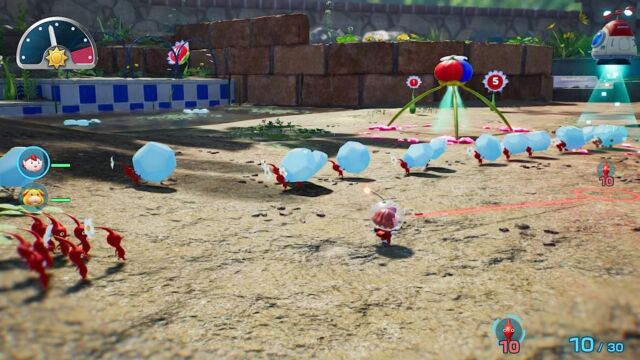
Why are you just standing around watching the Pikmin work? Go do something else!
Then came Pikmin 4 and its focus on “dandori,” which the game basically uses as a stand-in for “multitasking.” Practically every character and tutorial instruction box in the game is constantly pushing the gospel of dandori, begging you to make the most of your limited time here on Earth by helping the Pikmin get as much done as possible. Now, the game isn’t just about babysitting Pikmin, but about deploying multiple groups of them to different corners of the map as efficiently as possible.
That might sound stressful, but trying to maximize dandori strangely made me feel like I was actually accomplishing something more than moving a bunch of cute critters around a screen. It helps that the game’s maps are designed to distribute useful goals like breadcrumbs as you explore, making it easy to stumble on interesting sub-goals to complete. It also helps that the game isn’t actually that strict about punishing you for your lack of efficiency—your main punishment for inefficient dandori is that things just take a little longer than they would have otherwise.
After playing Pikmin 4, I found myself trying to maximize “dandori” in my own day-to-day life, managing the start times for things like laundry cycles and game downloads so I could efficiently multitask while waiting for them to complete. There aren’t many games that I can say affected my outlook on my own actions in quite the same way.
-Kyle Orland
Puzzmo
Zach Gage, Orta Therox; Web
Here at Ars, we’ve been fans of indie game designer Zach Gage’s take on puzzle games from Spelltower through to Knotwords. So when Gage launched a daily site full of newspaper-style puzzles, we were definitely going to check it out. What we didn’t know back then was that Puzzmo.com would become a daily obsession on the order of Wordle, but much deeper.

Puzzmo collects a number of Gage’s earlier work, like Spelltower, alongside new games like Typeshift—where you align columns of letters into complete words—and Wordbind, where you have to find the words hidden inside other words. Puzzmo also offers fresh takes on some old favorites, like a crossword puzzle that offers easily accessible hints for each clue if and when you get stuck (as well as handy lines on the grid to separate out multi-word answers).
It’s not just word games, though. Really Bad Chess, one of our favorite games of 2016, is offered here in a daily form that revives the old-school newspaper chess puzzle with randomized boards full of powerful pieces (you haven’t lived until you’ve cornered a king using four queens). Then there’s Flipart, an extremely satisfying block-arrangement puzzle where you click to rotate basic shapes until they fill in a grid completely with no overlaps.
Across all these varied games, excellent design makes the puzzles easy to play, while a ton of post-game statistics make it easy to compete with friends and other Puzzmo fans worldwide. But it’s also easy to ignore the competitive aspects and use Puzzmo to give your brain a quick break between other tasks. Best of all, you can try most of the puzzles for free before investing in an annual subscription that gives you access to more.
While there are plenty of games I enjoyed elsewhere on this list, Puzzmo is one of the few I’m relatively sure I’ll be playing daily for a good while into the future.
-Kyle Orland
Spider-Man 2
Insomniac; PS5
When the PlayStation 5 was first announced, a Spider-Man demo was
used as a primary example of what you could accomplish with the console’s extremely fast SSD storage. There’s a reason for that—zipping around the series’ realistic recreations of Manhattan are some of the most fun you can have on or off a Sony console.
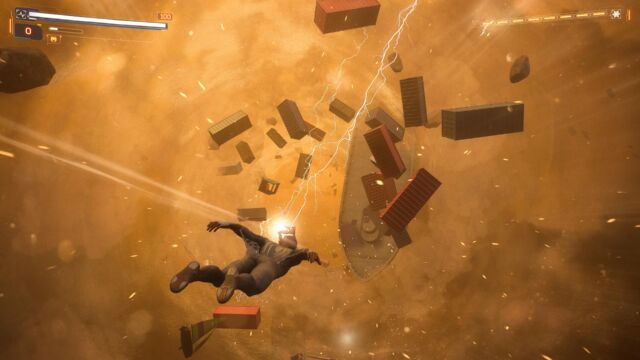
Arresting visual moments like these are ridiculously common in Spider-Man 2.
Insomniac / Sony
Spider-Man 2 lets you zip around faster than ever across a map that now extends to the outer boroughs, with a cast of playable characters that now includes two separate Spider-Men. Through it all, there’s plenty of the same best-in-class superhero battling that Insomniac established in the previous Spider-Man games. But the real highlight is simply navigating the environment, swinging between skyscrapers or gliding above them on web wings to look for a seemingly never-ending set of collectibles
The storyline is pure over-the-top comic book fluff, but there are moments of real heart buried there, especially in side missions that focus on a diverse cast of city dwellers with relatable problems that only a spider-like superhero can solve. These are balanced out by the requisite amount of high-octane action set-pieces, including a short but memorable section where you take control of a truly overpowered Venom and tear through literally everything in your path (extending this section into a full game doesn’t seem beyond imagining).
Spider-Man 2 might boil down to “more Spider-Man” in a lot of ways, but that’s not exactly a bad thing when the previous games have been some of our favorite open-world brawlers of the last few years.
-Kyle Orland
Starfield
Bethesda Game Studios; Windows, Xbox Series X|S
I don’t think 2023 has had a more divisive game than
Starfield, the latest from
The Elder Scrolls V: Skyrim developer Bethesda Game Studios. Detractors say it's slow-paced, old-fashioned, and janky. People who love it say it's relaxing, immersive, and compelling for the long haul. It's immensely popular with a certain crowd, but the butt of memes and jokes for another.
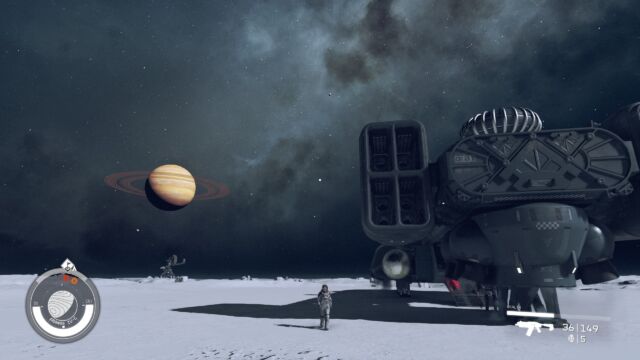
Starfield has some breathtaking vistas, if you know where to look.
For this love-it-or-hate-it game, put me in the love-it camp. At its heart, Starfield is a retro game firmly rooted in the design dreams and philosophies of the MS-DOS titles of the 1990s. Its structure has more in common with 1996's The Elder Scrolls II: Daggerfall than it does with 2011's The Elder Scrolls V: Skyrim. There's something missing from that era in many other modern AAA games: the relaxed pacing, the long-term planning, and a particular sci-fi aesthetic that is on the opposite end of the spectrum from space operas like Star Wars or Star Trek.
Like the games from which it draws, Starfield wants a lot of your time, and it expects you to set your own pace and figure out its intricacies on your own. The more you put in, the more it rewards you. The game's vast character progression system and even vaster playspace allow for hundreds of hours of zoned-out relaxation, but it's also the first Bethesda Game Studios game to get anywhere close to cracking what gunplay action should actually feel like. It gets a lot of things right.
The galaxy Starfield presents to the player accurately reflects the desolation of our own, but it's peppered with details in the art and dialogue that contribute to making one of the more believable sci-fi settings we've seen in games recently. Inon Zur's superb soundtrack draws from the best of the best in the science fiction canon, too.
Because of its comparatively narrow appeal, Starfield doesn’t quite reach the same “Game of the Year" heights as the wildly popular Skyrim. A formula that worked for a wide audience 10 or even 30 years ago has become a niche in a more vibrant and varied gaming landscape.
But all told, it's an outstanding game for a certain type of person, so it still makes our list.
-Samuel Axon
Street Fighter 6
Capcom; Windows, PS4/5, Xbox One/Series X|S
Street Fighter 6 set the bar for what a modern fighting game could be. The core is a set of well-balanced and interesting mechanics that offer a low skill floor to a high skill ceiling for players of all persuasions. No amount of bells and whistles matter if the actual gameplay isn’t fun, and
SF6 has delivered on that front. During one of my initial nights of hosting offline games, someone remarked that they were even having fun while losing, and that’s always a great sign.
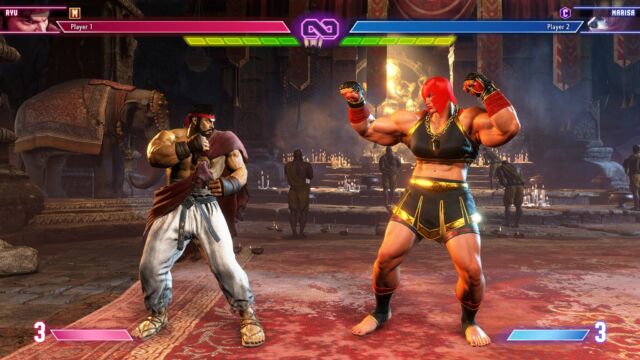
Original World Warrior Ryu faces off against newcomer Marisa. Note the M and C icons up top, indicating Modern and Classic controls.
SF6 is also served well by excellent rollback netcode that allows for competitive-level online play even from one side of the United States to the other—and to a lesser extent even overseas—letting almost anyone play other people easily if they don’t have friends who play or an offline venue to attend. The “anyone can play” approach even includes a variety of control schemes that range from a familiar experience for World Warrior veterans, to one more tuned for people who grew up with DualShocks instead of arcade sticks to a more party-mode-tuned button mashing that lets even complete new players feel like they can participate.
The cast of characters is a good blend of the classic and familiar, along with some later game favorites and a good diversity of new faces. But what sets SF6 apart from other fighting games is the story mode, which feels more like an actual game than a series of cut scenes interspersed with token fights. It’s not going to dethrone dedicated open-world games, but as a light fetch-quest RPG, it contains a satisfying amount of content for people who are less inclined to hop online and face human opponents. Capcom’s commitment to the story mode has extended to adding dedicated parts for each DLC character as they’re released.
The DLC is really the only mixed bag for the game. Buying new characters is a good value, and there is a new system to let you “rent” a character with virtual currency to try them before you buy them. But the cosmetic add-ons like new colors and costumes are priced pretty high. If you wanted to buy the latest batch of outfits for the launch roster, you’d be out around $100. That’s steep for a visual upgrade in what is not a free-to-play game. Thankfully, it’s all optional, and only completionists will feel the need to chase all of it.
If you have fond memories of playing SF2 in the arcades, or you’re just put off by modern fighting games that feel overly complicated or too competitively focused, Street Fighter 6 is an easy game to recommend.
-Aurich Lawson
Super Mario Bros. Wonder
Nintendo; Switch
A few months ago, I was talking to a friend who doesn’t follow video games too closely about playing
Super Mario Bros. Wonder. The friend expressed some mild shock that Nintendo was still making two-dimensional Mario games in the mold that he remembered from decades ago. Hadn’t that already been done to death, he wondered?
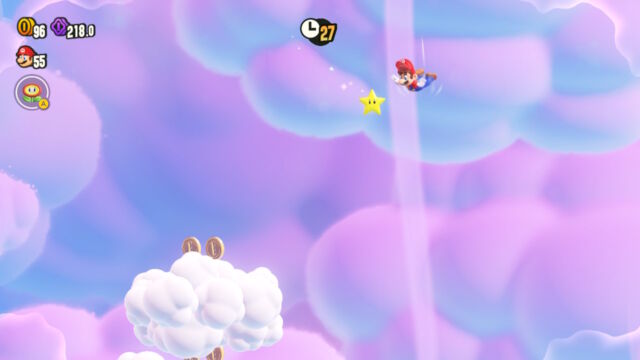
Cut scene from the canceled game "Mario the Skydiver."
Nintendo
His confusion was a bit understandable. After so much time and so many official titles (not to mention fan-made ROM hacks and Mario Maker levels), you might think the well of interesting, original 2D run-and-jump Mario content had been well and truly spent. On the contrary, though, Super Mario Bros. Wonder shows just how much life there is in the “simple” genre for a developer that’s willing to experiment.
The key innovation here is the titular Wonder Seeds, which infuse every level with the feeling of unexpected joy you might remember from the NES-era Mario games. Touching one of these seeds can lead to anything from an impromptu musical performance by singing-and-dancing piranha plants to a ride on a herd of stampeding beasts to a short pop quiz about your gameplay stats, and practically everything in between. This compelling variety that keeps you guessing what could come next and makes every level feel fresh is something many of the New Super Mario Bros. games never quite managed.
Add in some wonderfully vibrant 2D animation, an inventive series of power-ups and enhancement badges, and some novel online multiplayer strictures, and you have an exceedingly fresh take on what should, by all rights, be an outdated, tired genre. Super Mario Bros. Wonder proves that there’s plenty of life left in the Mario formula for developers willing to mess with it.
-Kyle Orland
Venba
Visai Games; Windows, PS5, Xbox One/Series X|S
In a year that was absolutely packed with excellent, multi-hour, big-budget epics, Venba stands out in part for its short length. This is a game that you can easily complete in a single evening, a large portion of which will be spent watching animated cut scenes recounting simple memories of domestic life.
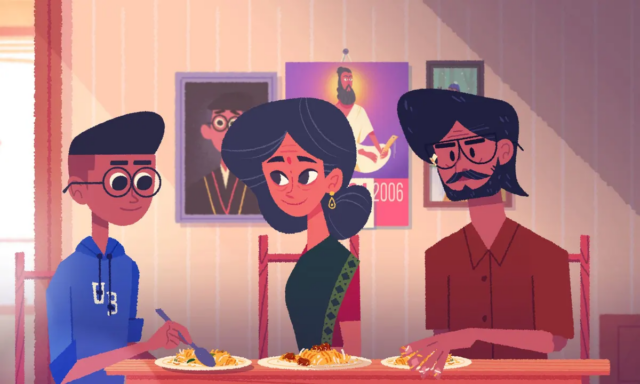
Venba tackles scenes of quiet domestic life in a way few other games even attempt.
Despite its abbreviated playtime, though, Venba has stuck with me as much or more than any other game on this year’s list. On the surface, the game simply recounts a few loosely connected stories of a family cooking Indian food, with some simple recipe-style minigames interspersed throughout to add a bit of interactive flair. But these vignettes add up to much more than the sum of their parts, merging into a touching intergenerational tale about the importance of family, the poignancy of aging, and the role of tradition in immigrant life.
More than that, Venba proves that video games can encompass more than just the power fantasies and clever little logic puzzles that dominate the industry’s most heavily marketed output. Those games have their place, as most of this list shows. But gaming as a medium would be better off if there were also more examples of small, personal stories like the ones shared in Venba.
-Kyle Orland
Viewfinder
Sad Owl Studios; Windows, PS4/5
Viewfinder serves as an almost too literal example of the adage that great art should be able to change your perspective on the world. Here, that perspective is the usual first-person projection of a three-dimensional world onto a two-dimensional monitor. But that standard perspective is recontextualized by the ability to snap a 2D photo of one part of the environment and project it onto another, creating new three-dimensional platforms, holes, or duplicate tools that help you solve some gentle spatial-relational puzzles.
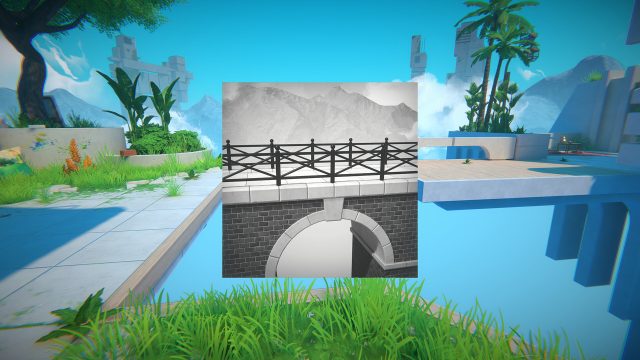
This looks like a good place for a bridge...
Sad Owl Studios
Viewfinder does a good job extending what could have been a gimmicky, one-note concept and constantly twisting it in ever-so-slightly unfamiliar ways to keep things fresh. Later levels require some truly lateral thinking to figure out how to use limited resources to cross seemingly impassable obstructions. And while the game reaches its abrupt conclusion just as its puzzles are finally hitting a good stride, it still leaves plenty of memorable moments in its wake.
In the great tradition of games like Portal, Antichamber, and Scale, Viewfinder’s perspective-warping conceit can change how you see the real world for hours after a play session. You’ll never look at a flat Polaroid photograph quite the same way.
-Kyle Orland
Yoyozo
Matt Sephton; Playdate
You’ll be forgiven if this one was not previously on your shortlist of must-play 2023 video games. I’ll admit that my soft spot for
Yoyozo is partly due to its role in
reviving my long-lost love of similar ‘90s indie PC game Pendulumania.
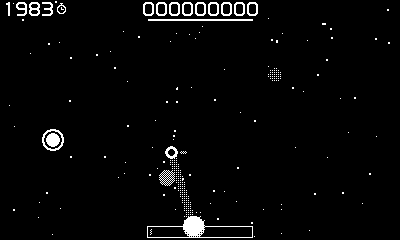
The Yoyozo gameplay GIF that helped unlock my Pendulumania memory block.
But Yoyozo has an appeal all its own as well. The game design is remarkably simple; you use the D-pad (and two quick-vertical-bump buttons) to control a small ring that is attached to a heavy ball by an elastic string. You move the ring to indirectly guide that ball into large stars appearing on the playfield, gaining extra points for ball speed, elastic stretch, and moving quickly enough to maintain an ever-increasing combo. Be careful, though; the ball gets heavier with each scoring star, and stretching the beam too far will snap it, ending your run.
It might not sound like a game that can sustain continuous interest, but since getting Yoyozo I’ve found myself frequently picking up the (previously underused) Playdate on my desk for what I tell myself will be a quick brain break during the day. That quick break often extends into many minutes of “just one more game” tries to set a new high score, a fact that has contributed to my appearance on the top 10 list of worldwide scores at the moment.
Yoyozo might seem like an outlier in a list full of massive, fully 3D worlds with sweeping storylines and dozens or hundreds of hours of chores to complete. But there’s something to be said for a game that executes perfectly on a simple idea. Yoyozo captures that easy-to-pick-up, hard-to-put-down quick action of a game like Super Hexagon or Geometry Wars and deserves to be mentioned in the same breath as those twitch classics.
- Kyle Orland
Ars Technica’s Game of the Year: Baldur's Gate 3
Larian Studios; Windows, MacOS, PS5, Xbox Series X|S
If there was any doubt that
Baldur’s Gate 3 was a different kind of role-playing game, it seems like it was settled in November. That’s when
the developers apologized for a bug that was, essentially, caused by the built-in Dungeon Master getting stuck while pondering your party’s sneaky deeds. There is a
lot going on inside this game’s engine and narrative, to the point where it can seemingly get lost inside its neuroses.
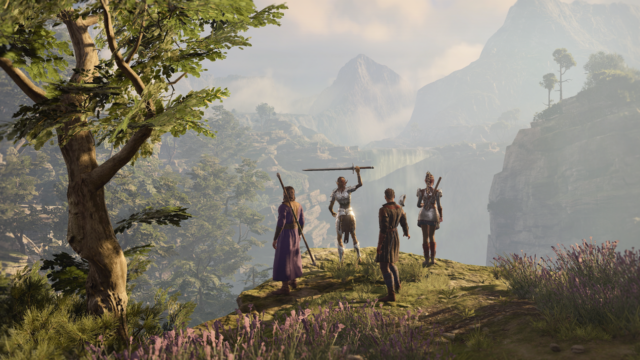
Raise your sword to the skies and take on fate—if you can pass this Constitution check. Otherwise, you might try sitting down.
Larian Studios
But that reactivity is also what makes BG3 great. It’s a game that never stops saying “Yes” to its players. You might not think there would be a voice line for a camp leader noticing that you’d stolen an item they wanted to give you as a reward, but there absolutely is. There are usually a half-dozen ways through any encounter, dialogue, or combat setup, and they’re not slight variations—they’re distinct options with consequences. Because the game is constantly having you make interesting choices, with real changes to the world and its people, replays are almost a given.
That kind of narrative and logical richness would be impressive enough were it not accompanied by a combat system that similarly rewards ingenuity (if also punishing bad luck). BG3 is also stuffed with intriguing, deep characters that grow, commune, and clash throughout a campaign—and absolutely wonderful voice acting, clever writing, and graphics that, while sometimes a bit clip-y, are still nice on the eyes.
BG3 is not wholly as flexible and creative as you and your friends playing a tabletop D&D campaign, but it’s so close as to be a masterpiece of RPG gaming.
-Kevin Purdy
Source





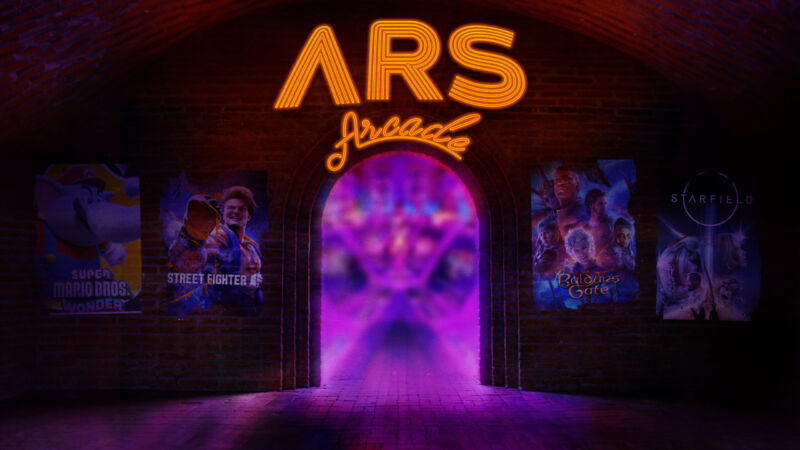
3175x175(CURRENT).thumb.jpg.b05acc060982b36f5891ba728e6d953c.jpg)

















Recommended Comments
There are no comments to display.
Join the conversation
You can post now and register later. If you have an account, sign in now to post with your account.
Note: Your post will require moderator approval before it will be visible.